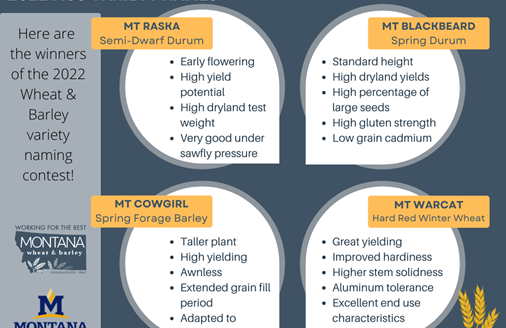For the first time, the Texas A&M AgriLife Wheat Field Day at the Bushland, Texas, Agricultural Experiment Station “took the show on the road” with a bus tour of wheat plots across the Panhandle. Stops included irrigated wheat trials at Bushland and near Dalhart, triticale plots near Conlen, and dryland wheat trials near Groom. This way, participants could see the variety trials in many environments and conditions.
Among the varieties on display were the two newest releases out of the Texas A&M AgriLife Wheat Improvement Program—TAM 115 and TAM 205. Both varieties offer quality characteristics that farmers may be able to capture added value from, explained Jackie Rudd, Texas A&M wheat breeder. While farmers get paid on yield, not quality, it’s the program’s hope that by releasing wheats with high quality characteristics that farmers can see their local basis at elevators rise and capture the value of these quality characteristics. If a region gets a reputation for quality wheat, buyers pay attention and will source from that region, Rudd explained.
Dual purpose TAM 115
TAM 115 is the latest in an effort to breed a dual purpose wheat that will offer good grain and forage yield under both dryland and irrigated conditions. TAM 115 is unique in that it may be later to flowering than most TAM varieties, but it has rapid grain fill when it does come to maturity. An added bonus is that taken to grain, this variety has large seeds, high test weights and strong dough properties sought by millers and bakers.
“It received above average milling and baking scores in the 2018 Wheat Quality Council evaluations,” Rudd explained.
For grazers, TAM 115 also offers some protection against wheat curl mites, the vectors of wheat streak mosaic virus. This is important in helping break the “green bridge” of these mites overwintering in volunteer wheat and then spreading the disease to production fields nearby. Its parentage includes TAM 112, which offers outstanding drought tolerance, and leaf and strip rust resistance too.
TAM varieties tend to perform across a wide swath of the hard red winter wheat territory, and TAM 115 is no exception. Rudd said it has performed exceedingly well as far as eastern Colorado and western Kansas, down into the rolling Plains and the Blacklands of Texas.
Bread-making TAM 205
TAM 205 is a hard red winter wheat that combines excellent bread-making qualities with production characteristics that allow it to perform well in the field and in the bakery.
Rudd explained that marker-assisted genetic selection helped in breeding TAM 205. With the WSM2 gene providing resistance to the wheat streak mosaic virus, this variety also offers stripe rust, leaf rust, stem rust, soil-borne wheat mosaic virus, spindle streak mosaic virus and fusarium head blight resistance. All of which are increasingly important in the southern High Plains growing region.
But, it’s the bread-making qualities that are TAM 205’s true selling points. Rudd said it received very good milling and baking scores in the 2019 Wheat Quality Council evaluations and makes an excellent pan bread.
More and more milling characteristics, such as protein quantity and quality and mixograph measurements are becoming increasingly important to the seed channel, Rudd told the tour. It’s not enough that wheat varieties perform well in the field, they also have to work in the bakery.
Forage needs
The tour also spent some time considering how wheat and triticale play important roles in the diets of dairy cattle in the expanding herds of the High Plains. Larger dairies are relocating to the plains, which means there’s an increasing need for forage year-round.
Texas A&M AgriLife is expanding its research into winter triticale in a rotation with corn for dairy forage. Using triticale as a cover crop over the winter captures water on dryland acres. And by double-cropping triticale and corn, while corn yields may be reduced, triticale more than makes up for the lost yield and overall more forage is yielded per acre, according to Juan Pineiro, AgriLife Extension dairy specialist, Amarillo.
“Texas is No. 5 in dairy production, we have half a million dairy cows, and 70 percent of our milk production in the state is here in the Panhandle,” Pineiro said. Combined with 2.5 million head of beef cattle, that’s 3 million head of cattle that need forages.
“But, that dairy cow needs more protein because she’s producing milk every day,” Pineiro said. Depending on the cow’s lactation cycle, she either needs more protein or more dry matter. Forages like triticale and wheat can help balance her diet depending at which stage they are harvested.
“If you need more fiber, you wait longer for it to mature and increase your yield,” he said. “If you need more crude protein, you can cut it earlier.” And, with triticale, dairy farmers may get a second cutting from regrowth.
Overall, the message from Bushland to Dalhart to Groom and back was that there are practical applications of research that can save producers costs and add more to their bottom lines.
Jennifer M. Latzke can be reached at 620-227-1807 or [email protected].




